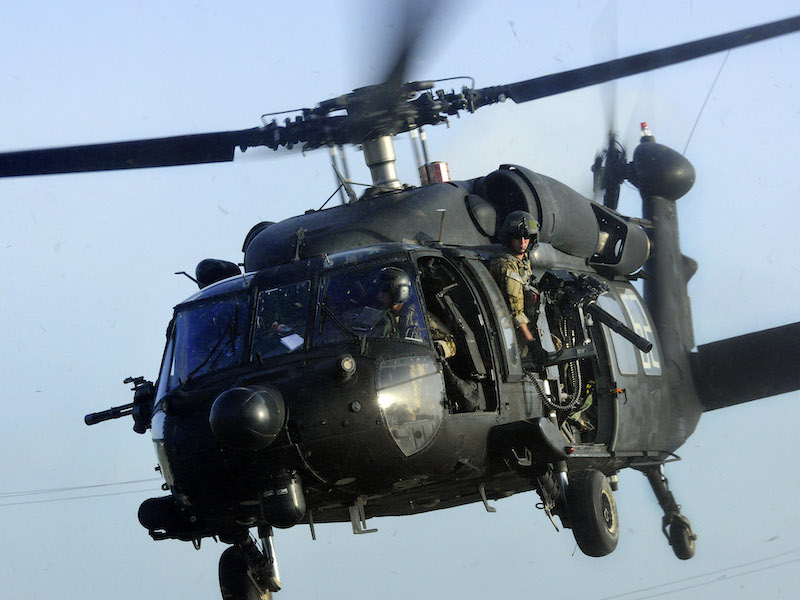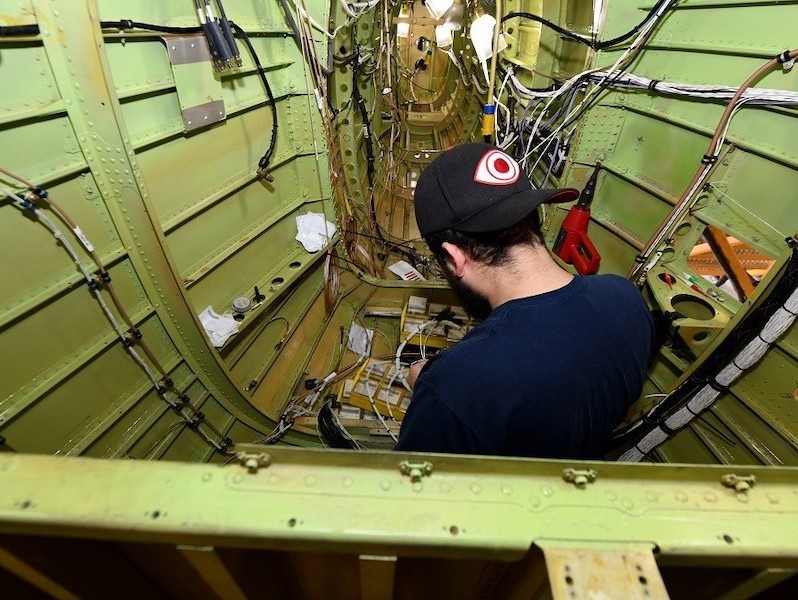A Black Hawk helicopter going through a recapitalization process at Corpus Christi Army Depot is the Army’s first aircraft to receive an undercoat unlike others in the aviation fleet.
The United States Army Aviation and Missile Command (AMCOM) used a “Class N” primer – free of a harmful substance called hexavalent chromium – to cover parts of the disassembled helicopter – showcasing a deliberate approach toward safer environments at depots, aircraft hangars and field environments where Soldiers and civilians perform maintenance.
To protect from corrosion and improve adhesion, paints and primers on military aircraft and vehicles often contain heavy metals, including hexavalent chromium, a toxin that requires employees to wear extensive personal protective equipment and other mitigation measures to safely apply and remove.
“AMCOM is proud to lead the way in implementing controls and protections that reduce our workforces’ exposure to harmful heavy metals,” AMCOM Commander Maj. Gen. Todd Royar said. “We are harnessing the results of dynamic research and testing and working in lock-step with our partners to create a path for others to follow.”
Reduce and Mitigate Heavy-metals Exposure
 While AMCOM and the Army have worked for over a decade to reduce and mitigate heavy-metals exposure, those efforts stepped up considerably in recent years since the American Conference of Governmental Industrial Hygienists lowered its threshold for “permissible exposure.” The Army in December 2018 adopted the more stringent standard as defined by the ACGIH.
While AMCOM and the Army have worked for over a decade to reduce and mitigate heavy-metals exposure, those efforts stepped up considerably in recent years since the American Conference of Governmental Industrial Hygienists lowered its threshold for “permissible exposure.” The Army in December 2018 adopted the more stringent standard as defined by the ACGIH.
Workers at Corpus Christi Army Depot who perform activities that remove paint from the aircraft they refurbish use many forms of protection and engineering controls while they sand, grind or cut parts, which sends heavy-metal dust into the air. Downdraft tables, air showers and protective clothing are part of the efforts aimed at reducing exposure from heavy-metal dust that’s been created from the refurbishment process, said Will Quinn, AMCOM’s chief of operational safety.
“CCAD is leading the Army in hexavalent chromium reduction across the depot,” said CCAD’s Deputy Commander Mark Wagner, whose team has implemented many initiatives and programs geared to eliminate heavy metals from its processes.
As it has validated measures in the past, Quinn said Corpus Christi Army Depot is the process proving ground as this first Black Hawk with the “Class N” primer emerges from its recapitalization process.
“This is the first step in reaching our ultimate goal of removing these materials from the process all together,” Quinn said. “When this process if validated, it will be part of the production line and a model for others to follow.”
27 Locations is a Concern
Besides Corpus Christi Army Depot, AMCOM also oversees Letterkenny Army Depot in Pennsylvania and fleet maintenance sites across the country – a total of 27 locations where heavy-metals exposure is a concern.
AMCOM’s Heavy Metals Working Group, which Quinn helps lead, includes about 60 people who represent the locations, directorates and expertise necessary to combat the issue. Besides hexavalent chromium, the group also tracks other heavy metals including lead, cadmium and beryllium.
By the end of 2019, the group finalized the identification of all AMCOM areas that produce heavy-metal exposure. While assessments are ongoing, AMCOM continues to implement, explore and expand control measures at each location.
While eliminating heavy-metal exposure is important to the health of the workforce, it is also critical to ensure that these new materials and processes do not degrade fleet performance. For years, Army researchers and engineers have been testing new materials and methods to reduce the risk of heavy metals. In partnership with AMCOM’s internal logistics directorate (G-4), experts from the Combat Capabilities Development Command, Aviation & Missile Center and the Army Research Laboratory have been developing, evaluating and validating each one of these new materials and processes to address both workforce safety and mission readiness.
“Army researchers continue to develop viable coatings, adhesives and sealants alternatives that will ultimately be approved for use on Army weapons systems,” said Mark Feathers, AMCOM G-4 lead project manager and a member of the Heavy Metals Working Group. “In addition to this primer preplacement, they are currently supporting another 10 hexavalent chrome elimination projects in the Corpus Christi Army Depot plating shop alone.”
As hexavalent chrome alternatives are being implemented, Feathers said he and the entire working group are proud of AMCOM and the Army’s collective accomplishments.
“As we progress, our processes and materials will change and the requirement for personal protective equipment will diminish as we incorporate our advancements into our current and future facilities,” Feathers said. “As these materials, processes and sustainment infrastructure are proven at the depot, we will push them out to the rest of AMCOM, the Army, sister services and our original equipment manufacturers to maximize the positive impacts.”
Modifying Maintenance and Sustainment Contracts
The working group’s efforts also include identifying and prioritizing projects to ensure alternatives with the greatest mission capability and less potential workforce exposure are pursued first, determining the costs and then laying out funding requirements to systematically target reducing heavy-metals exposure. While resource managers establish funding requirements, Army Contracting Command plays an important role in modifying maintenance and sustainment contracts and updating language for acquisitions.
While cost is a significant consideration, Royar noted the most important objective is the safety and health of the workforce whose main effort is repairing and refurbishing equipment to get it back in the hands of warfighters.
Royar said he is equally focused on the equipment of the future. To that end, the heavy metals team is engaging the Army Futures Command’s Future Vertical Lift Cross Functional Team to ensure it is aware of and considers alternatives to primers and paints that contain heavy metals for the Army’s next generation of aircraft.
Beyond aviation, the lessons learned at Corpus Christi Army Depot and AMCOM have application Armywide, particularly on military vehicles.
Because of his previous work at AMCOM, Quinn was recently tapped to join the Department of the Army’s Heavy Metal Working Group where he will be able to impart the expertise and accomplishments of AMCOM’s efforts.
“We’ve made significant strides at AMCOM,” AMCOM Safety Director Patricia Vittitow said. “We are honored and humbled to have representation at the higher level and to share what we have learned as we continue our efforts to safeguard our workforce.”
Courtesy of the U.S. Army. Original link: https://www.army.mil/article/236283/amcom_leads_effort_to_reduce_heavy_metal_exposure



































